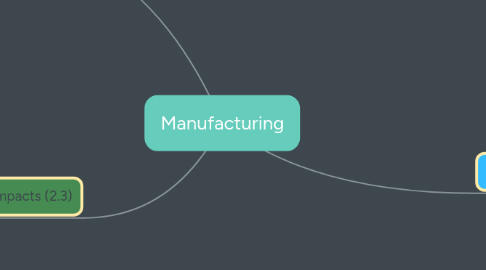
1. Manufacturing Over TIme (2.2)
1.1. Cottage Industries - the process of manufacturing in one's own home (Ex. textiles, pottery, carpentry)
1.1.1. Animate Power - power supplied by animals or people themselves
1.2. Industrial Revolution - A technological revolution that improved industries and social, economic, and political development
1.2.1. Fossil Fuels - energy formed from the residue of plants and animals buried millions of years ago (coal, natural gas, petroleum)
2. Environmental Impacts (2.3)
2.1. Air Pollution - hazardous gases and solid particles contaminating the atmosphere
2.1.1. Greenhouse Effect - the increase of Earth’s temperature caused by greenhouse gases (Ex. carbon dioxide, methane) trapping radiation inside the atmosphere
2.2. Acid Precipitation - the process of sulfur dioxides and nitrogen oxides (released from the burning of fossil fuels)
2.3. Water Pollution - the pollution of bodies of water, as well as groundwater
2.3.1. Effects on Humans - pollutes clean water, needed for consuming, cooking, agriculture, and industry
2.3.2. Effects on Aquatic Life - waste that enters the water takes oxygen to decompose, and thus, fish will not have enough oxygen to survive
2.4. Sanitary Landfill - toxic waste that is contained at a site and isolated from the environment until it is safe
3. Factors of Production (2.1)
3.1. Site Factors
3.1.1. Land - the amount of natural resources available
3.1.2. Labor - the amount and skill of workers in the company
3.1.3. Capital - the amount of wealth a company has
3.1.4. Entrepreneurship - the act of setting up a business and taking financial risks
3.2. Situation Factors
3.2.1. Bulk-Reducing Industry
3.2.1.1. Proximity - inputs: Transportation of raw materials is more expensive than transportation of finished product.
3.2.1.2. Production - raw materials outweigh the finished product
3.2.2. Bulk-Gaining Industry
3.2.2.1. Proximity - markets: Transportation of finished product is more expensive than transportation of raw materials.
3.2.2.2. Production - the finished product outweighs the raw materials
3.3. Integration
3.3.1. Vertical Integration - controlling multiple phases of production (Ex. extraction, refining, marketing)
3.3.2. Horizontal Integration - buying out other similar companies
3.3.3. Outsourcing - depending on foreign suppliers for resources or labor (opposite of Vertical Integration)
3.4. Types of Production
3.4.1. Fordist - mass production involving unskilled labor. Named after Henry Ford's assembly line method
3.4.1.1. Each person has 1 specific job they must do to keep productivity at its highest.
3.4.1.2. More common in developing countries where unskilled labor is abundant.
3.4.2. Post-Fordist - skilled labor where workers collaborate and make discoveries together
3.4.2.1. They often must be able to perform various jobs rather than 1 task. These workers often have college degrees and need to use complex machinery.
3.4.2.2. Leveling- all workers are treated alike. Managers do not receive drastically different treatment than other employees.
3.4.2.3. More suitable for developed countries, like the US, where a greater proportion of the population has some sort of higher education.
